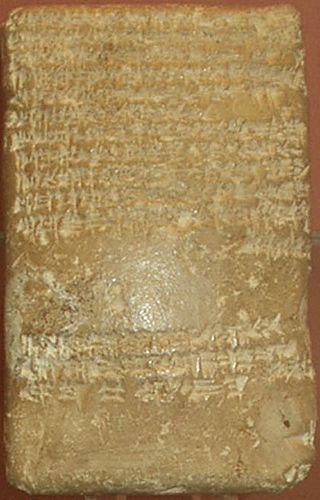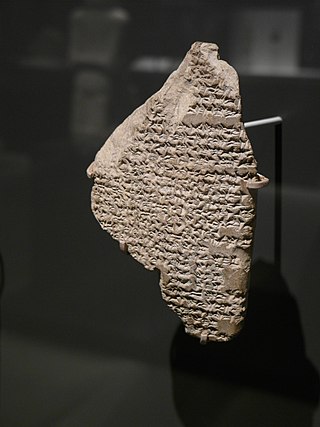Pirissi and Tulubri are a pair of messengers of the 1350–1335 BC Amarna letters correspondence. Pirissi and Tulubri are the messengers of King Tushratta of Mitanni, and are referenced in Amarna letters EA 27, 28, and EA 29,.

Amarna letter EA 19 is a tall clay tablet letter of 13 paragraphs, in relatively pristine condition, with some minor flaws on the clay, but a complete enough story that some included words can complete the story of the letter. Entitled "Love and Gold", the letter is about gold from Egypt, love between father-king ancestors and the current relationship between the King of Mitanni and the Pharaoh of Misri (Egypt), and marriage of women from King Tushratta of Mitanni to the Pharaoh of Egypt.

Amarna letter EA 9 is a tall, compact 38 line clay tablet letter of 3 paragraphs, in pristine condition, with few flaws on the clay. The photo of the reverse (pictured) shows half of Paragraph III, and some of the signs.

Amarna letter EA 35, titled The Hand of Nergal, is a moderate length clay tablet letter from the king of Alashiya to the king (pharaoh) of Egypt. The letter has multiple short paragraphs, with scribed, single-lines showing the paragraphing. Paragraphs I-VII are on the letter's obverse; paragraph VIII starts at the bottom edge and continues, ending at Paragraph XIII on the clay tablet's reverse.

Amarna letter EA 289, titled: "A Reckoning Demanded," is a moderately tall, finely-inscribed clay tablet letter, approximately 6.5 in tall, from Abdi-Heba the mayor/ruler of Jerusalem, of the mid 14th century BC Amarna letters. The scribe of his six letters to Egypt were penned by the "Jerusalem scribe"; EA 289 is a moderately long, and involved letter, mentioning ten named individuals, some more than three times. A total of nine locations are referenced, as well as men of the "Hapiru"-("LÚ-MEŠ-Hapiru-ki"), and men of "Qilyi-ki".

Amarna letter EA 15, titled Assyria Joins the International Scene, is a shorter-length clay tablet Amarna letter from Ashur-uballit I of the Land of Assyria,. He addresses the Pharaoh in line 1, the "King (of) Land Miṣri-(Egypt)", thus the use of "Land (of) Assyria".

Amarna Letter EA5, one of the Amarna letters, is a correspondence between Kadašman-Enlil I and Amenhotep III.

Amarna Letter EA10 is the letter of the Amarna series of diplomatic correspondence designated EA 10, which is written in cuneiform writing showing the continuation of a correspondence between Burna-Buriash II an ancient king of Babylon, and Akhenaten, an ancient pharaoh of Egypt.

Amarna letter EA 23, titled: "A Goddess Travels to Egypt", is a short letter to Pharaoh from Tushratta. Due to the ill health of Pharaoh, a statue of Goddess Šauška is being sent to Egypt, to aid in the health of Pharaoh.

Amarna letter EA 205, titled: "Ready for Marching Orders (5)" is a short letter from the Ruler of city Ṭubu. The title references that six mostly identical, very short, letters were scribed by the same scribe, from small regional towns; the scribe also is the writer of Amarna letter EA 195. It is not known if each letter was written at the location of each town, or from an alternative site, or sites.

Amarna letter EA 38, titled A Brotherly Quarrel, is a letter from the King of Alashiya. One identifier of many of the Amarna letters, is the use of paragraphing. Six paragraphs are in this letter, with much of the letter's reverse – uninscribed.

Amarna letter EA 223, titled: "Compliance With Orders", is a very short clay tablet letter from Endaruta of city-state Akšapa (Achshaph). It is the only letter authored by Endaruta. One of the ten Pharaoh letters written to persons/ or states in the Amarna letters corpus, is Amarna letter EA 367.

Amarna letter EA 290, titled: "Three Against One", is one of the two shorter letters, of six, from Abdi-Heba the governing man of Jerusalem. In the Jerusalem letters, Jerusalem is "Uru-Salem" ("City-Peace").

Amarna letter EA 59, titled: "From the Citizens of Tunip", is a short- to moderate-length clay tablet Amarna letter from the city-state of Tunip, written to the Pharaoh of Egypt. Only one other city sent a clay tablet Amarna letter to the Pharaoh, namely Irqata, letter EA 100, titled: "The City of Irqata to the King".

Amarna letter EA 156, titled: "Aziru of Amurru", is a very short letter from Aziru, the leader of the region of Amurru. EA 156 is the first letter in a series of 16 letters regarding Aziru.

Amarna letter EA 158, titled: "Father and Son", is a moderate length letter from Aziru, the leader of the region of Amurru. The letter is written to the Egyptian official, Tutu/ (Dudu). EA 158 is the third letter in a series of 16 letters regarding Aziru.

Amarna letter EA 170, titled: "To Aziru in Egypt", is a moderate length letter, from Aziru, the leader of the region of Amurru. EA 170 is the fifteenth letter in a series of 16 letters regarding Aziru.

Amarna letter EA 34, titled: "The Pharaoh's Reproach Answered", is a moderately tall clay tablet Amarna letter from the King of Alashiya.

Amarna letter EA 299, titled: "A Plea for Help", is a fairly short clay tablet Amarna letter from "governor" Yapahu of city-state Gazru. The clay tablet surface has been partially eroded, but the cuneiform is still mostly legible.
Amarna letter EA 147, titled A Hymn to the Pharaoh, is a moderate length clay tablet Amarna letter from Abimilku of Tyre-(called Ṣurru in the Abimilku letters, and an island, until the time of Alexander the Great, 330 BC). The letter is a twin letter to EA 149, which is identical in length, and complexity, and EA 147 appears to precede EA 149.














